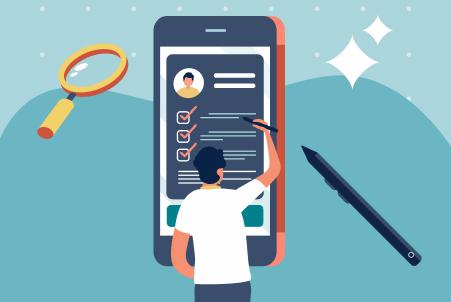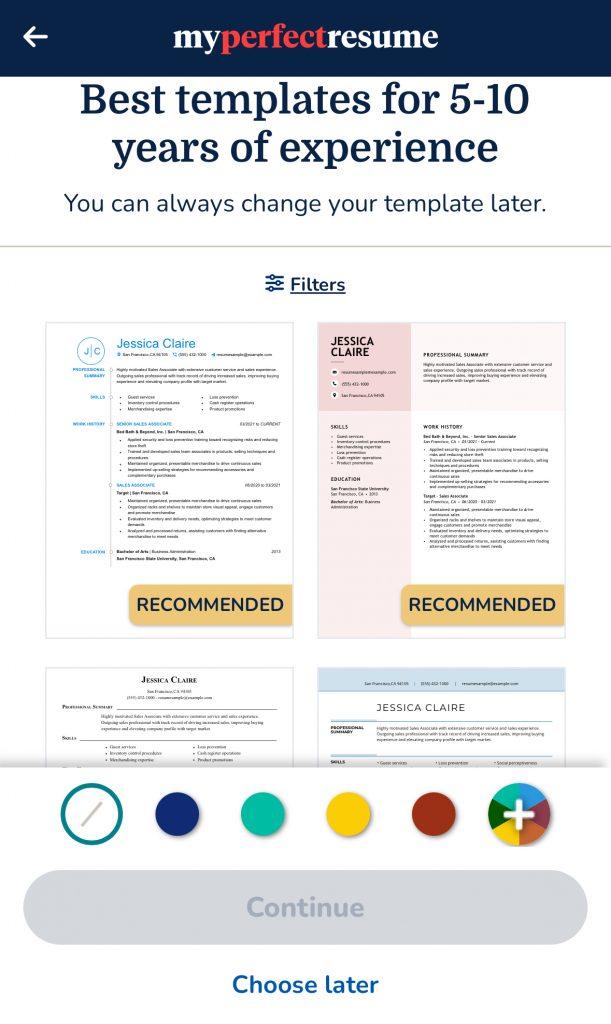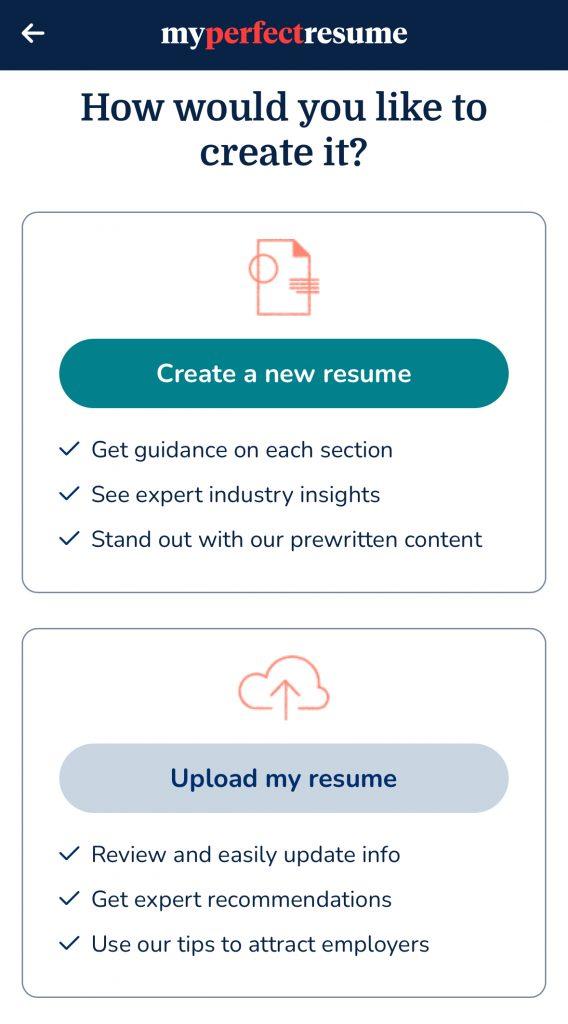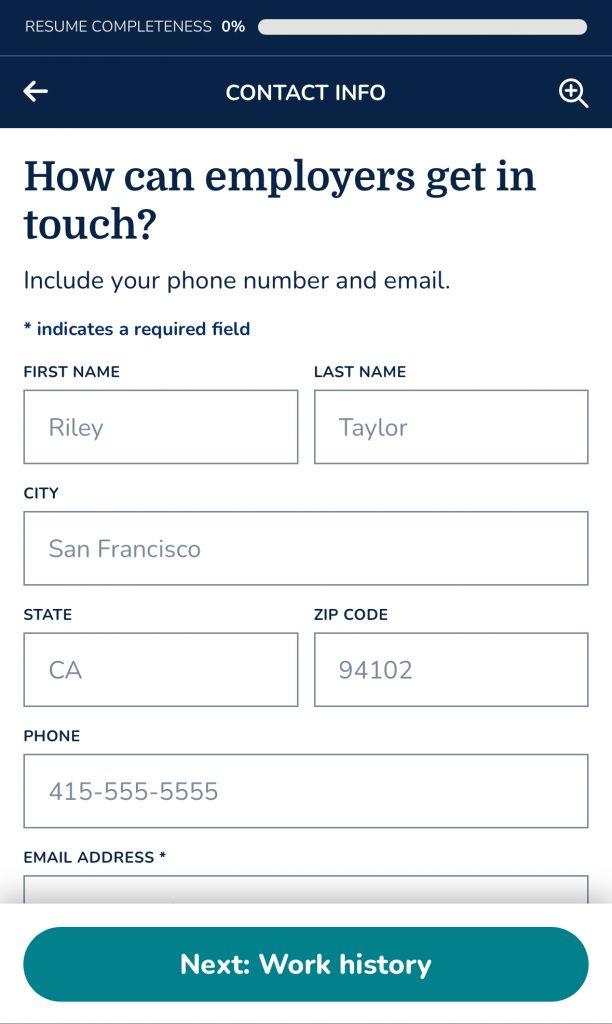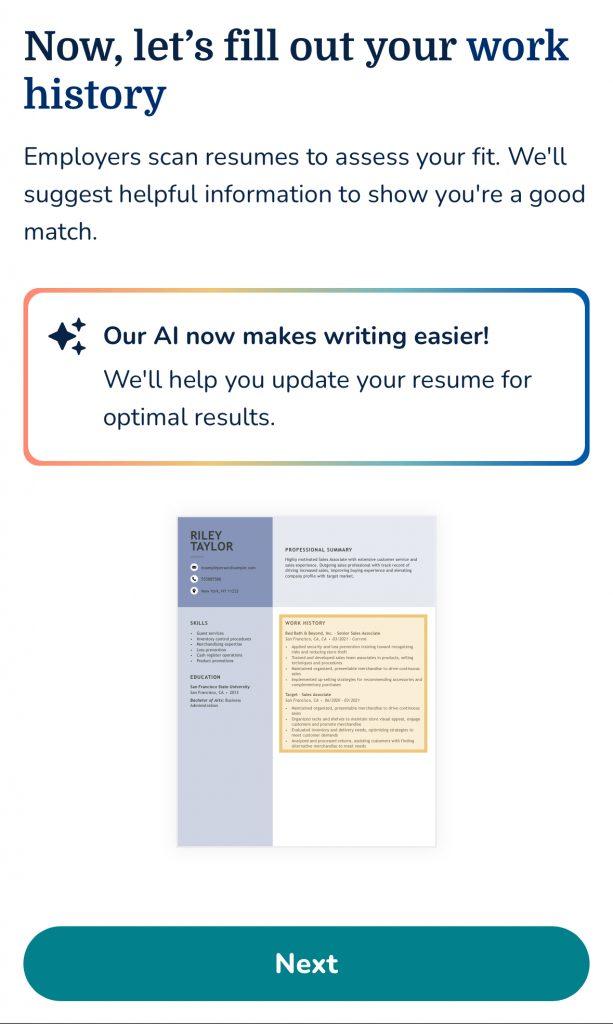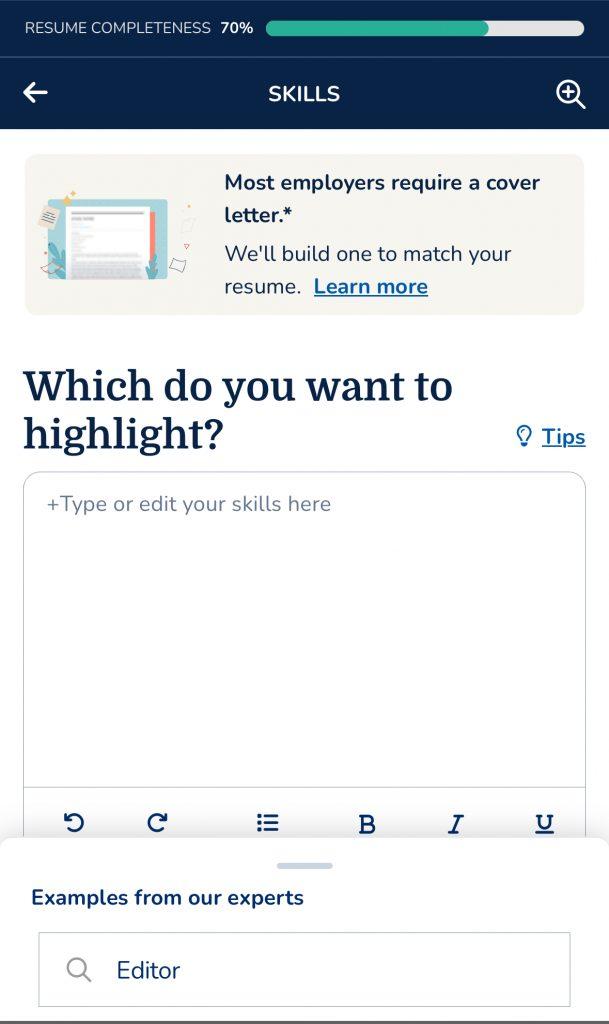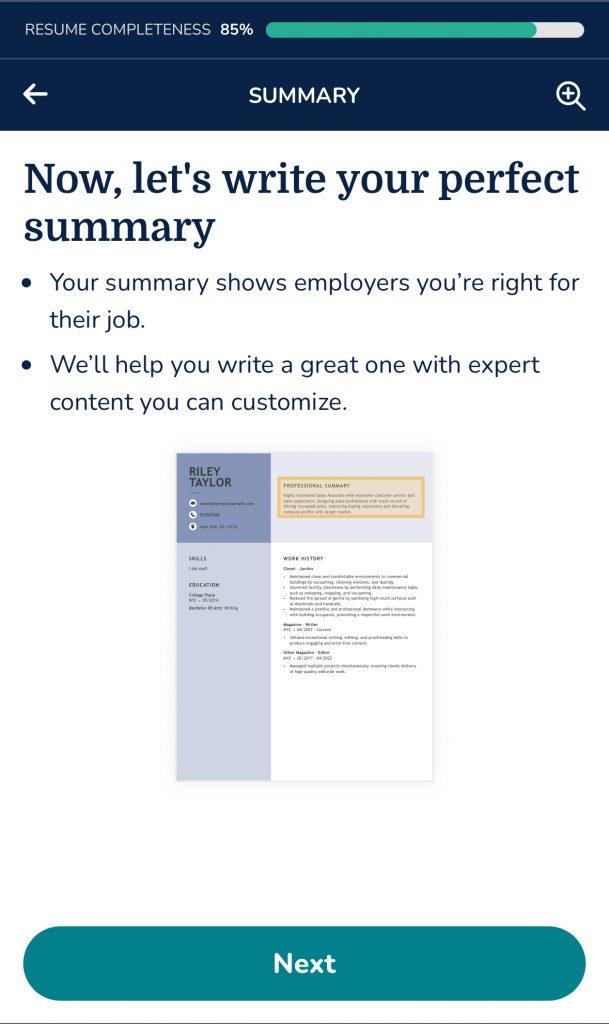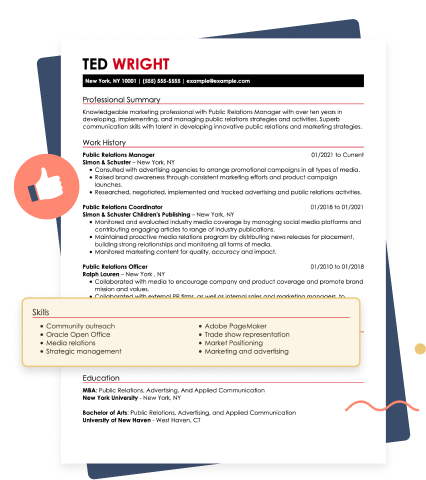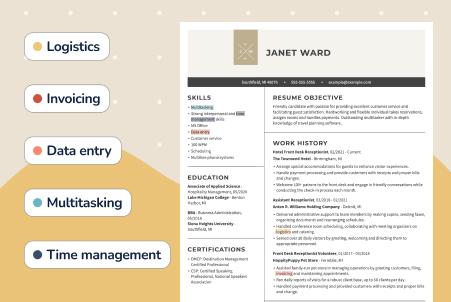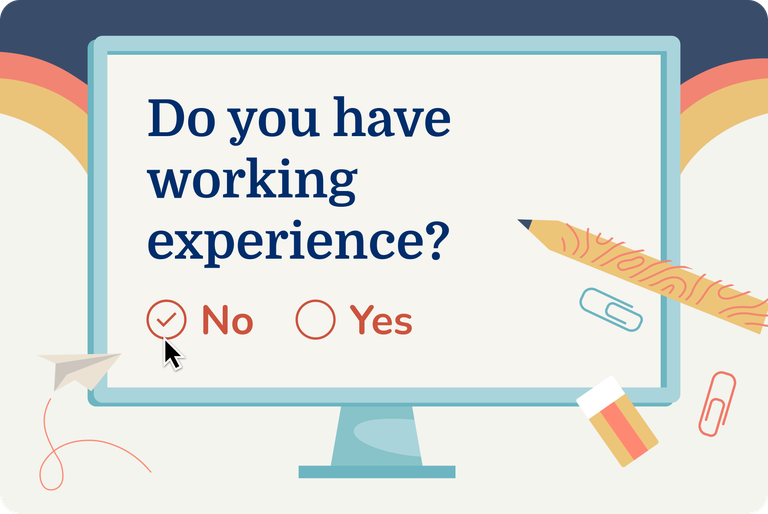How Can I Make a Resume on My Phone? Tips & Examples

Our customers have been hired at: *Foot Note
In a world where we’re either online or fast on the move, the smartphone has become the main tool for many things, including job hunting. This begs the question: can you actually make a professional-looking resume on your phone?
With the right software, the right technique, and proper formatting, you can definitely make a great resume and send it on its way right then and there.
Our guide will walk you through the best ways to make a resume on mobile, including the best apps and essential tips to ensure your resume gets you that coveted interview.
Jump to the following sections:
- Why would I make a resume on my phone?
- How can I make a good resume on my phone?
- What to include on your mobile resume
- Making sure your mobile resume works
- Pros and cons of making a resume on your phone
- Can I actually make a good resume on mobile?
Use our Resume Builder to create a stunning resume on desktop or mobile!
Why Would I Make a Resume on My Phone?
Making a resume on your phone instead of a computer is a matter of convenience. There are many situations in which using your phone makes more sense.
First, if you don’t have access to a computer, your phone is the best alternative. While its small size makes it potentially uncomfortable to use compared to a regular computer, your phone provides almost the same formatting and design tools.
Additionally, your phone makes it easy to work on your resume on the go. If you’re busy working another job, attending class, taking care of family, or commuting long distances, you can work on your resume whenever you catch a break.
How to Make a Resume on Your Phone
When creating a professional resume on your phone, you need to choose the right tool for the job. From dedicated online resume builders that’ll help you from beginning to end, to popular word processing software like Microsoft Word and Apple Pages, there is an option that will work for you.
Read on to see how these tools work and how to use them to make the best possible resume.
Using resume builders to write your resume
Resume builders are software designed specifically for making resumes. The best AI resume builders include guides, premade customizable templates, application tracking system (ATS) checkers, and help you write all the sections of your resume. As with many other tools, there are mobile app versions you can access directly from your phone.
Resume builders are easy to use since they guide you step by step through the resume-writing process. Here are some steps you’ll see when working with a builder:
Option 1: Select your preferred template
Resume builders provide a wide range of professionally crafted templates. After selecting your years of experience, the builder will recommend templates appropriate for your experience level.
You can choose different structures and resume formats, from a work history-focused template for experienced candidates to a balanced format with skills and work experience side by side for newer professionals.
Option 2: Upload your existing resume
You can also upload an existing resume to most builders, and get help editing it and optimizing it.
Fill out your header
Next, you’ll fill out your contact information for your header. You’ll get to see a real-time preview of what your resume looks like as you start filling out your details.
Fill out your work history
As you move along, you’ll add the different job positions you’ve held throughout the years, along with your tasks and responsibilities. When you enter each job title, the builder will automatically suggest tasks that align with the role for you to add to your resume easily.
Add skills and keywords
You will then be prompted to add your skills. Most builders, such as our Resume Builder, provide expert recommendations of top skills in your industry. Add the ones that match your expertise and write in any that aren’t listed, especially specific hard or technical skills like software programs.
This is also an opportunity to match your skills with those mentioned in the job description to make your resume ATS-friendly.
Write and customize your summary
Resume builders create a professional summary using all the information you’ve added. This gives you a starting point that you can customize to fit your expertise and to give it more personality.
You can also write your own from scratch. Some builders will aid in that process with suggestions and corrections.
Preview, edit, and download
Take one last look at your resume. Now that it's filled out, make sure the format is to your liking; consider colors, positioning of sections, font, and font size.
Finally, proofread it. While the builder may have minimized grammatical mistakes, informational errors can still be present, such as incorrect years or misspelled company names.
Using word processing software to write your resume
Word processing software — like Microsoft Word, Apple Pages, and Google Docs, among others — is a great option for making a resume on your phone. There are mobile app versions of these programs with most of the features you can get on a desktop, such as templates, formatting options, and cloud compatibility.
Find or download a template
There are resume templates available in the majority of word processing software, so you can select a premade template and fill in the information. You can find even more options online, on websites such as MyPerfectResume, which have resume templates formatted for specific word processing software.
Fill in your information
When filling out your resume template, keep your sentences concise, use bullet points, and focus on the most important roles and tasks that accurately portray your experience.
Write your resume summary and work history tasks
Although templates usually include sample copy for summaries and tasks, they are just that: samples. You’ll have to fill in your own personal details. Be thoughtful and intentional about what you write.
Your resume summary should include your top skills and enthusiasm for the job. Your work tasks should be detailed, using action verbs and measurable achievements.
Ensure your formatting is on point
Although you’re working within a template, as you add your content, the formatting may break when using word processing software. Move sections around to ensure your content is neatly structured within one or two pages. Use font wisely: stick to professional fonts such as Calibri or Times New Roman, and keep the font size between 10 and 12 points.
Proofread and ask for opinions
Make sure everything is correct, from grammar to information. A small slip-up could mean your resume doesn’t pass the ATS filters. Ask a friend or mentor to look at it as well, as a pair of fresh eyes always helps.
Export and revise the format
Finally, export your resume to the necessary format — most employers require PDF, but sometimes they might prefer another format, such as .docx (Word). Revise your resume each time you export it since certain parts of the document, such as spacing and font, could be altered.
What to Include on Your Mobile Resume
A resume made on your phone is the same as any other resume — it’s just the execution that changes. If you’re working directly on your phone and need pointers on how to make a resume, here are the most important sections to include.
Name and contact information
Every resume starts with proper identification. At the very top, write your full name. It should be large and noticeable. You can add some color to the font or the background and select a slightly bolder font than the rest of the resume.
Below your name, add your contact information. Include your:
- City, state, and zip code (not your full address)
- Email address
- Phone number
If applicable, add any professional links such as LinkedIn, a professional portfolio, Bold.pro profile, or a website.
Professional summary
Your professional summary, which is your elevator pitch to the recruiter or hiring manager, will be below your contact information.
It’s important to be direct and concise, but provide enough detail to paint an accurate picture of what you can bring as a potential employee. Here’s an example of what an effective professional summary should look like:
Work history
The work experience section is the central part of most resumes. Include recent and relevant positions that demonstrate your knowledge and capabilities.
Organize them in reverse-chronological order to prioritize your most recent role — assuming it’s also highly relevant to the job you’re applying for. For each role, describe your tasks and responsibilities using action verbs and measurable achievements backed by statistics. For example:
- Delivered engaging lesson plans covering U.S. and World History, aligning with state curriculum standards.
- Assessed student progress through quizzes, essays, and projects, improving class-wide test scores by 18%.
- Organized interactive activities, including debates and historical simulations, to enhance student participation and critical thinking.
Avoid vague statements, such as “Taught AP English” or “Responsible for senior class.”
Skills
In your skills section, you’ll list the most important and relevant skills you’ve developed, including specific software proficiency or knowledge of certain processes. This is your opportunity to include keywords from the job description.
Your level of experience can help you determine where to place this section:
- New to the job market: Place it at the top to bring more attention to your capabilities instead of your work experience.
- Working for three to nine years: Place your skills next to your work history to show you have a strong skill set alongside your experience.
- Working 10+ years: Prioritize your valuable work history and place your skills section at the bottom.
Education
The education section will usually be smaller than the rest. Add your school name, your major, and your year of graduation. You don’t have to include your GPA, but it’s recommended if you just graduated and are looking for your first job — but only if it’s 3.5 or higher. If you graduated over 10 years ago, consider leaving your graduation date out, as it’s no longer relevant.
For academic or research-related jobs, which might require much more educational information, you’ll likely be required to hand in a CV instead of a resume.
Other sections
Depending on your career stage and field, you can add additional sections to your resume. Here are some examples of sections you can include:
- Certifications: Include any certificates you have earned for completed courses or training in a field or area relevant to your career.
- Volunteer work: If you have little to no experience, adding volunteer work can provide context for your skills. It can also be a beneficial addition if it’s directly relevant to your field.
- Awards and honors: Include any awards and honors you have received to show how your abilities and contributions have been recognized.
- Publications: Research skills and thought leadership are highly valuable, so including your publications can set you apart from other candidates, especially when applying for jobs in academic or scientific fields.
Making Sure Your Mobile Resume Works
While making a resume on your phone is convenient, you still need to put in the effort to create a competitive resume that will get you the interview.
Here are some additional tips on how to write a resume to ensure it is in optimal condition before hitting that share or attach button.
1. Keep it to one page
It’s usually best to write a one-page resume, but it’s even more recommended if you’re creating it on mobile. While resume principles are the same, keeping it short and simple significantly reduces room for error.
Also, other than just making it on mobile, consider what the resume will look like on a phone or tablet. Many recruiters and employers are on the move just like you and will most likely see your resume on their mobile devices, so create a resume that’s legible on small screens.
How you organize sections, the colors you use, and the font size (this last one might entail reducing the content, so be concise and choose what you include wisely) all contribute to your resume’s legibility.
Pro tip:
You can submit a two-page resume if you have vast experience or are applying for high-level positions.
2. Double-check formatting
Formatting inconsistencies are a common issue when creating a resume on your phone. It may look one way on the small screen and a different way on a desktop computer. How a resume looks will also depend on the software you use, and testing across platforms, such as Pages or Word, might be more difficult.
Double-check your formatting and test it across multiple devices to ensure legibility. If you’re wondering what a good resume looks like, look at resume examples to take inspiration from their formatting and structure.
3. Proofread thoroughly
Like with your format, proofreading your resume becomes even more critical when working on a mobile device. The size of the screen and the keyboard make writing uncomfortable, which can increase the likelihood of making mistakes.
Typos and mistakes can be costly, so proofread your resume twice or more, and share it with colleagues, friends, or mentors to get valuable feedback.
4. Save and export as a PDF
One of the best ways to ensure your format is correct and can be seen correctly across platforms and devices is to export it as a PDF. This will save you a lot of time and potential issues.
Be mindful, however, that many companies or third-party application services require specific formats for your resume, such as .docx (Microsoft Word). So, if this is the case, double-check that the format looks good across different devices when you export your resume.
Pros and Cons of Making a Resume on Your Phone
Of course, there are both pros and cons to making a resume on your phone. Here are some to consider:
Convenience: Work on your resume anywhere, anytime.
Instant access: Save and edit your resume quickly.
Prebuilt templates: Many apps offer resume templates to streamline the process.
Cloud integration: Sync with services like Google Drive, Dropbox, or iCloud.
Small screen: Formatting issues may be more challenging to catch.
Typing errors: Increased risk of typos due to smaller keyboards.
Limited features: Some mobile apps may not support advanced resume customization.
Resume Example
So Can I Make a Good Resume on Mobile?
You can definitely make a good resume on your phone or tablet; it’s just a matter of recognizing limitations and working with and around them to ensure a professional-looking resume.
With the large variety of apps and online resume builders available, you can quickly and effectively make a job-winning resume wherever you are. Choose the best tool for you and start working on landing that next job!
Key Takeaways
- You can create a professional, high-quality resume on your smartphone.
- Use mobile-friendly resume builders or word processing software with mobile apps.
- Double-check formatting, export to PDF, and test your resume across multiple devices.
- Keep it concise and use templates that work well on mobile, as it will likely be read on mobile.
FAQ
How do I avoid formatting mistakes when working on a small screen?
First, keep the resume to one page to avoid major formatting issues that will be challenging to fix on your phone screen.
Second, fill in the template as best you can, focusing on being concise. Use bullet points to make it easy to scan.
Finally, export it to PDF and see how it looks when you open it. You might have to do this each time you make a significant change, but ensuring your resume is in top shape will be worth the trouble.
Can I write a cover letter on my phone?
Today, most companies require a cover letter, and even if they don’t, including one can give you an edge.
Similar to online resume builders, there are online cover letter builders, such as our Cover Letter Generator, which help you write and polish your cover letter or refine a cover letter you’ve already written.
You can also use any word processing software app, just like with resumes.
Do I need to include every job I’ve had on my resume?
No, it’s not necessary to include every job you’ve ever had on your resume. Think about the positions you’ve had and make the selection based on how relevant it is to the job you’re applying for, how long ago you had that job, and how it would fit into your resume.
If you have little to no experience, you may want to maximize each role you’ve held; if you have a lot of experience, prioritize the most recent and most important roles.
Our customers have been hired at:*Foot Note
